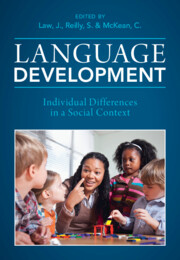Book contents
- Language Development
- Language Development
- Copyright page
- Contents
- Figures
- Tables
- Contributors
- A Tribute to Our Friend, Colleague and Fellow Editor, Professor James Law
- Introduction
- Part One Factors Influencing Language Development
- Part Two Continuity and Change
- Part Three Impact, Intervention and Equity
- 15 Communication, Participation and Cohort Studies
- 16 Capturing the Voice of Parents and Children
- 17 Oral Language Skills as a Foundation for Learning to Learn
- 18 The Economic Impact of Low Language Ability in Childhood
- 19 A Review of Interventions to Promote Language Development in Early Childhood
- 20 Interventions to Promote Language Development in Typical and Atypical Populations
- 21 The Effect of Kindergarten Instructional Policies on Reading and Math Achievement Gaps
- 22 Educational Interventions Targeting Language Development
- 23 Equity and Access to Services for Children with Language Difficulties
- Index
- References
18 - The Economic Impact of Low Language Ability in Childhood
from Part Three - Impact, Intervention and Equity
Published online by Cambridge University Press: 11 August 2022
- Language Development
- Language Development
- Copyright page
- Contents
- Figures
- Tables
- Contributors
- A Tribute to Our Friend, Colleague and Fellow Editor, Professor James Law
- Introduction
- Part One Factors Influencing Language Development
- Part Two Continuity and Change
- Part Three Impact, Intervention and Equity
- 15 Communication, Participation and Cohort Studies
- 16 Capturing the Voice of Parents and Children
- 17 Oral Language Skills as a Foundation for Learning to Learn
- 18 The Economic Impact of Low Language Ability in Childhood
- 19 A Review of Interventions to Promote Language Development in Early Childhood
- 20 Interventions to Promote Language Development in Typical and Atypical Populations
- 21 The Effect of Kindergarten Instructional Policies on Reading and Math Achievement Gaps
- 22 Educational Interventions Targeting Language Development
- 23 Equity and Access to Services for Children with Language Difficulties
- Index
- References
Summary
Low language ability has profound implications for education outcomes, employment opportunities, health literacy, parenting, and social inequalities. However, little is known about the economic impact of children experiencing low language on health, education and employment systems, specifically for children with low language that persists over time. This book chapter examines the impact of low language on service use and costs from early childhood to adolescence (4–13 years) using data from a longitudinal community-based Australian study, the Early Language in Victoria Study. Patterns of different service use and costs associated with low language from 4’13 years were described. Under-servicing (child had identified needs but did not access services) and over-servicing (child used services but had no identified needs) were examined. Key predictors for the use of services associated with low language, such as parental concern about their child’s speech and language and financial barriers, were also explored. The chapter concludes with a discussion about the findings, their clinical and policy implications, and future directions for research and practice, together with the strengths and limitations of the study.
Keywords
- Type
- Chapter
- Information
- Language DevelopmentIndividual Differences in a Social Context, pp. 420 - 442Publisher: Cambridge University PressPrint publication year: 2022



